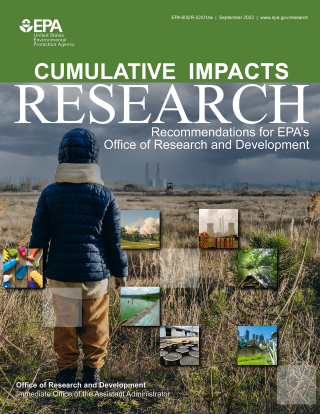Cumulative Impacts Research
Following the Science

EPA’s programs and policies have greatly improved air, water, and soil quality and reduced chemical exposures as measured with national indicators. Scientific evaluations of the distribution of pollution-emitting facilities, adverse environmental exposures, and environmental health impacts show, however, that some places have substantially higher levels of environmental pollution and related adverse health conditions than others.
EPA has proposed that adding a consideration of the cumulative impacts of existing pollution levels and associated health status into its decision-making processes will improve its ability to fulfill its mission to protect human health and the environment. EPA has made cumulative impacts research a priority to bolster the scientific basis for developing approaches for evaluating and improving environmental conditions in America’s communities.
How EPA’s Research is Addressing Cumulative Impacts
Solving longstanding environmental health problems requires an accurate and realistic assessment of the effects from combined exposures to chemical and non-chemical stressors (cumulative impacts) that inform decision-making at all levels.
EPA’s Office of Research and Development (ORD) aims to support federal, tribal, state, and community decision-making by strengthening the scientific foundation for assessing cumulative impacts, exposures, and risks through existing and new methods, tools, data, and monitoring. Cumulative impacts research is a priority to bolster the scientific basis for identifying actions that can improve community health and well-being.
Over the past year, ORD developed fiscal years 2023-2026 Strategic Research Action Plans (StRAPs) for each of its six National Research Programs. The StRAPs integrate efforts to improve our understanding of cumulative impacts to support real-world assessments of both adverse and beneficial health and environmental effects.
Cumulative Impacts Research Report

ORD published the final report, Cumulative Impacts Research: Recommendations for EPA’s Office of Research and Development, to inform the 2023-2026 StRAPs. This report focuses on recommendations to enhance cumulative impact research that are applicable across the National Research Programs and includes recommendations for how ORD can provide management support to facilitate this complex research.
This report represents ORD’s commitment to develop an integrated cumulative impact research portfolio, in collaboration with others, to inform decision-making at all levels.
- The recommendations in the report are already informing actions within ORD to advance the state of the science, and we are prepared to do more as we implement cumulative impacts research in the years to come.
- Building on the broad input we received from partners and stakeholders, the report presents recommendations that will assist ORD with integrating research efforts to improve our understanding of cumulative impacts and conduct real-world assessments.
- Both cumulative impacts and cumulative impact assessment are defined in the interest of providing clarity and consistency across ORD’s research portfolio.
- Research gaps and barriers to implementing cumulative impact research at EPA are identified and recommendations are made for advancing this research as an explicit part of each of ORD’s six 2023-2026 StRAPs.
- Recommendations are provided for cumulative impact assessments that will address the unique vulnerabilities of children and vulnerable populations.
This report was prepared by an interdisciplinary group of EPA scientists and experts. It is based on the scientific literature, with input from EPA programs and regions; states, tribes, and community representatives; and the EPA Science Advisory Board (SAB) and public comments collected during SAB consultation.
Download the report: Cumulative Impacts: Recommendations for ORD Research (PDF)
Research Grant Information
EPA provides grants and funding to the nation's leading researchers to improve the scientific basis for decisions on health and environmental issues. You can sign up to receive email notifications about research grant opportunities and news releases.
| Status | Name |
|---|---|
| Closed for Application | |
| Closed for Application | |
| Awarded | |
| Awarded |
Centers for Early Lifestage Vulnerabilities to Environmental Stressors |
| Awarded | |
| Closed Grant |
Integrating Human Health and Well-Being with Ecosystem Services |
| Closed Grant |
Search for Cumulative Impact Research Publications
EPA's Science Inventory is a searchable database of research products primarily from EPA's Office of Research and Development. Science Inventory records provide descriptions of the product, contact information, and links to available printed material or websites.
See Cumulative Impacts Research Publications in the Science Inventory

